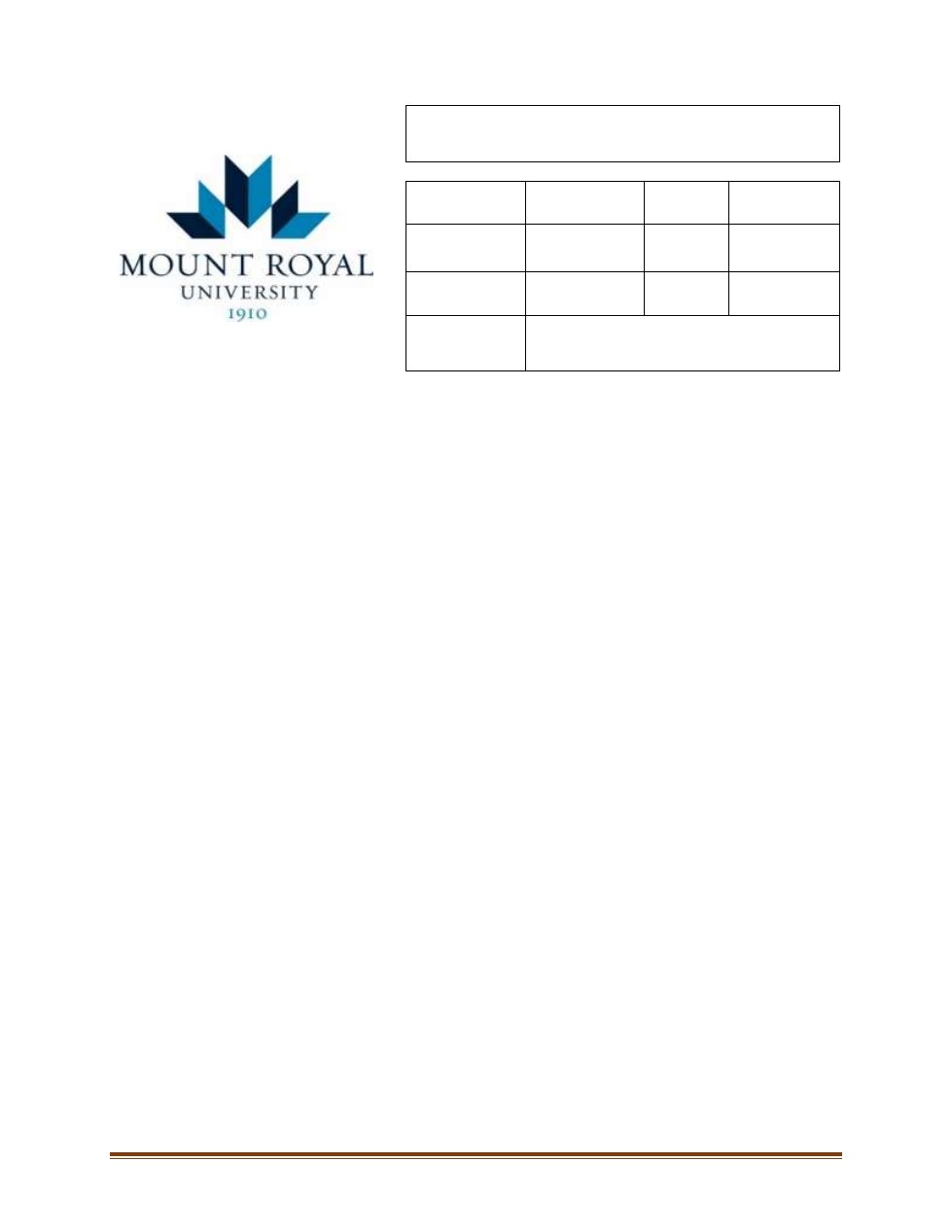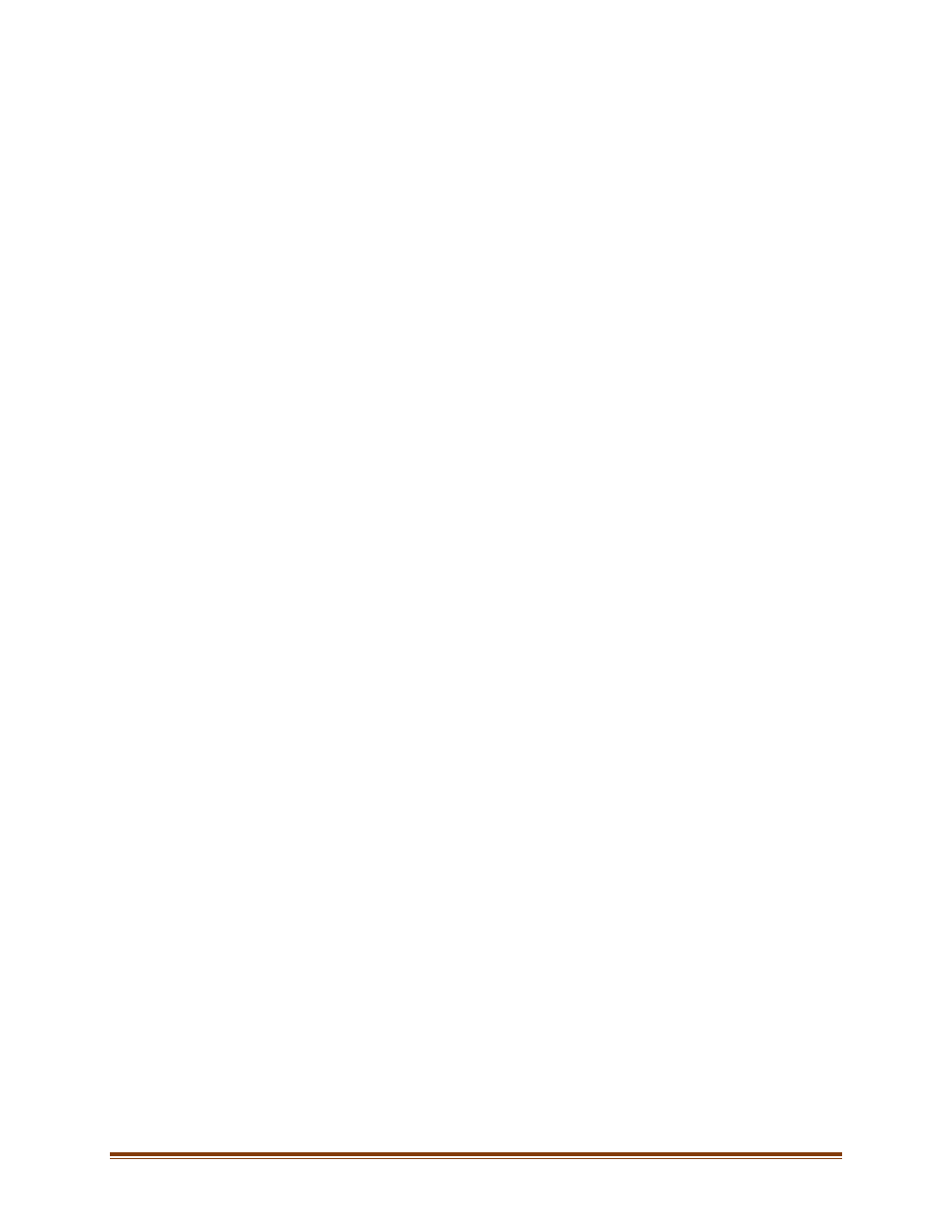
Program Definitions Policy – March 15, 2018
Page 1 of 10
PROGRAM DEFINITIONS POLICY
Policy Type:
Academic
Initially
Approved:
October 26,
2007
Policy Sponsor:
Provost & Vice-
President,
Academic
Last
Revised:
March 15, 2018
Policy Contact:
Registrar & AVP
Enrollment
Management
Review
Scheduled: September 2025
Approver:
General Faculties Council
A.
PURPOSE
The Program Definitions Policy governs the development and delivery of the curriculum for Mount
Royal's programs. In order to ensure that its programs are consistent with the standards of quality
for undergraduate education in Canada, Mount Royal University has established principles that
inform the development and delivery of its programs. It also has defined academic criteria that
certificate, diploma, applied degree and baccalaureate degree programs must satisfy.
B.
SCOPE
This Policy applies to all credit programs at Mount Royal University. It also includes stipulations
around credit-free certificates, the University Entrance Option, and Open Studies.
C.
POLICY STATEMENT
1.
PRINCIPLES
1.1
Curriculum is developed in compliance with the guidelines set out by the Campus
Alberta Quality Council (CAQC).
1.2
Curriculum is informed by explicitly stated values of Mount Royal University.
1.3
All programs are planned and developed so that they incorporate effective principles
and processes of learning.
1.4
All programs explicitly identify graduate outcomes.
1.5
All degree, applied degree and diploma programs include core disciplinary or
professional studies as well as General Education and Electives.
1.6
All programs relate to theory to practice.
1.7
All Courses credited to a Mount Royal post-secondary credential must be post-
secondary level Courses. Courses or Course equivalents that are used to satisfy a
high school or senior matriculation requirement are not at a post-secondary level.

Program Definitions Policy – March 15, 2018
Page 2 of 10
2.
PROGRAM DEFINITIONS
2.1
Program Core -- The Program Core is a set of prescribed Courses within a program
that defines the primary area of study or major. Courses taken to satisfy this
component of the program may not also be used to satisfy requirements in either of
the other categories.
The limits on Program Core/Major is specified below.
2.2
General Education -- General Education is the part of the curriculum shared by all
students that is primarily responsible for meeting the requirement for liberal
education. Courses taken to satisfy this component of the program may not also be
used to satisfy requirements in either of the other categories. Normally, General
Education constitutes a minimum of 10 courses from the total number of courses that
make up the program.
2.3
Options -- Options are defined course choices within the Program Core.
2.4
Electives -- Elective requirements can be satisfied with any university-level Course
that students choose without restriction (except for meeting Course prerequisites).
Normally, Electives constitute a minimum of four (4) Courses from the total number
of Courses that make up the program.
2.5
Course -- In the context of this Policy, a Course is interpreted to have a minimum
credit value of three (3). Courses with a credit value of less than three (3) must be
aggregated to meet a program requirement for the number of Courses.
2.6
Cognate Course -- In the context of this Policy, a Cognate Course is a Course from
outside a defined discipline which complements and enhances the breadth of
knowledge and skills found within the area of study.
2.7
Major -- A Major is a prescribed set of no less than 14 Courses or normally no more
than 26 Courses within a 40-Course program. The designation for Major will
normally appear on the transcript and the degree parchment.
a. Normally, a Major is comprised of Courses with the same discipline prefix.
b. Majors within an interdisciplinary program (i.e., one based on a combination and
integration of Courses) are comprised primarily of Courses with the same
discipline prefix but also include Cognate Courses.
2.8
Minor -- A Minor is comprised of no less than six (6) and no more than eight (8)
prescribed Courses (including approved Options). The designation for Minor will
appear on the transcript but not on the degree parchment.
2.9
Concentration -- A Concentration resides within the Major and represents an
increased focus on a particular area of study. A Concentration is comprised of no
less than six (6) and no more than 10 prescribed Courses (including approved
Options). The designation for Concentration will appear on the transcript but not on
the degree parchment.
2.10
Combined Degree -- A Combined Degree is a merger of two distinct degrees and
is based on a prescribed curriculum, typically negotiated between two faculties, and
approved by General Faculties Council.
2.11
'Degree After' -- A student who has accepted an offer admission to a second degree
at Mount Royal after being awarded a first is considered to be in a 'Degree After'

Program Definitions Policy – March 15, 2018
Page 3 of 10
arrangement. Considerations for residency, transfer credit will be part of the
institutional decision.
2.12
Joint Degree -- A Joint Degree allows a student from an institutional partner to
complete a portion of a Mount Royal degree as part of the program at their home
institution. Students admitted into a Joint Degree program receive a transcript that
reflects their admission into a Joint Degree program.
3.
RESTRICTIONS
3.1
Minors/Double Minors
a. Minors must be constructed to ensure that students can complete them without
taking additional Courses outside of the Minor.
b. No more than 50% of Courses in a Minor can be at the 1000 level.
c. Minors must be constructed with a minimum of one (1) 3000-level (or above)
Course
d. No more than 50% of Courses, up to a maximum of four (4) Courses, can be
used to satisfy both the Minor and the Major/Concentration requirements.
e. Courses used to satisfy a General Education and/or Elective requirement can
also be used to satisfy a requirement for a Minor.
f. Students may pursue a maximum of two (2) Minors within a degree program.
g. No more than 50% of Courses used to satisfy the requirements for one (1) Minor
can be used to satisfy requirements for a second Minor.
3.2
Concentrations
a. Concentrations must be constructed with a maximum of three (3) 1000-level
Courses and a minimum of two (2) 3000-level (or above) Courses.
b. Courses used to satisfy Concentration requirements cannot be used to satisfy
General Education or Elective requirements.
c. Students may pursue a maximum of two (2) Concentrations within a Major,
provided the Concentrations do not have any Courses in common.
3.3
Double Majors
a. Discipline choices for a double major must be made within a single degree.
b. All core requirements for each Major must be satisfied in a manner approved by
the Dean.
c. All General Education requirements for the degree must be satisfied.
d. A maximum of four (4) General Education Courses can be used to satisfy the
program requirements for a Double Major.
e. Courses which satisfy an Elective requirement can be used to satisfy the
program requirements for a Double Major.

Program Definitions Policy – March 15, 2018
Page 4 of 10
3.4
Combined Degree
a. A Combined Degree program must be based on a minimum of 50 Courses (150
credits).
b. All General Education requirements for a single degree must be satisfied within
the combination unless an exception received General Faculties Council
approval.
c. A maximum of four (4) General Education (12 credits) Courses can be used to
satisfy the Program Core requirements for the Combined Degrees.
d. Courses which satisfy an Elective requirement can be used to satisfy program
core requirements within a Combined Degree without restriction.
3.5
Joint Degree
a. Joint baccalaureate degree programs must be based on a contractual academic
partnership between Mount Royal and a recognized institutional partner.
b. The terms of agreement for the academic partnership must specifically address
how the integrity of a Mount Royal credential will be maintained.
c. A Joint baccalaureate degree must consist of Courses in a minimum of two
categories: Program Corfe and General Education. The number of Courses in
each category must be specified in the agreement between Mount Royal and the
partner institution.
d. Curricular content is subject to approval by the General Faculties Council.
e. Notwithstanding Mount Royal’s residency policy, the contractual agreement
between Mount Royal and a partner institution may include provisions that are
contrary to current Mount Royal policy.
3.6
Time Limitation for Completion of Credentials
a. Normally, there is no time limitation for the application of credit toward a Mount
Royal credential for any Course completed at Mount Royal or at any recognized
accredited post-secondary institution.
b. Time limitations may be imposed if Course content is particularly time-sensitive.
Any such time limitations must be approved by the Dean of the appropriate
Faculty upon recommendation from the Chair.
c. All graduation requirements for a baccalaureate/applied degree must be
completed within eight (8) years of admission into the program.
d. All graduate requirements for a diploma or certificate must be completed within
six (6) years of admission into the program.
e. Any student who is unable to complete a credential within the stated time limits
will be removed from the program and be required to apply for readmission.

Program Definitions Policy – March 15, 2018
Page 5 of 10
4.
CERTIFICATE CREDENTIALS
4.1
Credit Certificate
Programs offering this type of credential may include Program Core Courses,
Electives, and approved Options (minimum of 18 credits and six (6) Courses).
Generally, programs of this type will be from six (6) to 10 Courses in length and will
focus on professional development, post-diploma or post-baccalaureate education.
4.2
Certificate of Achievement
Given to acknowledge completion of an approved series of related credit Courses
(minimum of nine (9) credits and three (3) Courses. Generally, programs of this type
will be from three (3) to five (5) Courses in length and will focus on professional
development.
4.3
Credit-free Certificate
Programs offering this type of credential include at least three (3) required Program
Core Courses and in addition, there may be a series of Options from which a
specified number may be selected. Programs of this type must have a minimum of
60 instructional hours and individual Courses within the program will not usually be
less than 15 hours in length.
5.
DIPLOMA PROGRAMS (effective Fall 2010)
All diploma programs must satisfy the following requirements:
5.1
Program Core Courses (no fewer than 12 courses or 36 credits) and approved
Options.
5.2
A minimum of five (5) General Education Courses as follows:
a. At least one (1) course must be from each of the four (4) General Education
thematic clusters at either the foundation or higher level.
b. One (1) of the five (5) Courses taken must be a foundation level General
Education Cluster Four Course.
5.3
No Level 30 equivalent or lower Course (or equivalents) shall be accepted in
fulfillment of a graduate requirement in an Option or Elective category.
5.4
Generally, diploma programs will have a minimum of 20 Courses (minimum of 60
credits) and a maximum of 24 Courses (maximum of 72 credits).
6.
APPLIED DEGREE PROGRAMS
Applied degree programs will include or be supplemented by required experiential learning
courses (e.g., practicum, field work, directed field study, internship, or clinical placement).

Program Definitions Policy – March 15, 2018
Page 6 of 10
6.1
Applied Degree Program Duration
Applied degree programs require a minimum of 40, three-credit Courses and shall
not require more than 44 three-credit Courses (or equivalent).
6.2
Applied Degree Program Definition
a. Program Core
In addition to traditional classroom-based Courses, an applied degree must
include a minimum of 30 credits to be delivered through experiential learning,
which may be embedded in classroom-based Courses or other Courses.
b. General Education (effective Fall 2013)
i.
Students registered in applied degree programs are required to take eight
(8) Courses identified as satisfying the General Education requirements.
ii.
Four (4) Courses will be taken at the foundation level: one (1) from each
of the General Education program’s four thematic cluster areas.
iii.
Four (4) Courses will be taken at the second or third tier: one (1) from
each of the thematic clusters.
c. Electives
An applied degree must include at least one (1) Course of a student’s choosing
without restriction.
7.
BACCALAUREATE DEGREE PROGRAMS
7.1
A baccalaureate degree is a Ministerally-approved program consisting of no less
than 120 credits that is comprised of a Program Core (including approved Options),
General Education and Electives, as outlined below. Because of accreditation
requirements, the number of Courses in the elements below may vary.
a. Program Core
Normally, the Program Core will not be more than 26 Courses within a 40-Course
program.
b. General Education
i.
General Education requirements in a program will normally consist of 10
Courses.
ii.
Four (4) Courses will be taken at the foundation level: one (1) from each
of the General Education Program’s four (4) thematic cluster areas.
iii.
Three (3) Courses will be taken at the second tier: no more than one (1)
from each of the thematic clusters.
Non-BSc students must include a selection from the Numeracy and
Scientific Literacy cluster at Tier 2.
BSc students will make their Tier 2 selections from clusters other than
Numeracy and Scientific Literacy.

Program Definitions Policy – March 15, 2018
Page 7 of 10
iv.
Three (3) must be taken at the third tier, selected from at least two (2) of
the thematic clusters.
c. Electives
Normally, Electives constitute a minimum of four (4) Courses from the total
number of Courses that make up the program.
7.2
A maximum of 16 junior (1000-level) Courses may be used to satisfy requirements
for a baccalaureate degree.
7.3
A maximum of 24 Courses in any one discipline may be used to satisfy requirements
for a baccalaureate degree.
8.
EXEMPTIONS FROM PROGRAM DEFINITIONS
In cases where there are demonstrable accreditation requirements that would necessitate an
exemption from the stated definitions, programs may apply to General Faculties Council for
a modification of the Program Definition requirements. Where such modifications are
necessary, they should be made while retaining as much of the normally prescribed Program
Definition requirements as possible.
9.
UNIVERSITY ENTRANCE OPTION
The University Entrance Option is designed for students who intend to apply to another Mount
Royal program but may lack specified admission requirements or do not meet the competitive
admission average for the program. Admission to the University Entrance Option does not
guarantee subsequent admission to a Mount Royal program.
9.1
Students do not graduate from the University Entrance Option. This fact
distinguishes it from degree, diploma, and certificate programs.
9.2
A University Entrance student is not eligible to receive a Letter of Permission to take
a Course or Courses from other institutions.
9.3
Students can complete a maximum of 30 credits (normally ten (10) courses) as a
University Entrance student. This limit includes any credit Courses which the student
may have taken as an Open Studies student. The limit does not include credit-free
high school equivalency Courses.
9.4
Students who reach this limit and who have not been admitted into a Mount Royal
program will not be permitted to register in additional credit Courses and may not
apply to Open Studies. There is no appeal process to extend this limit.
10. OPEN STUDIES
Open Studies is intended to remove many of the significant barriers inherent in a competitive
admissions process thereby providing opportunities for a variety of students to pursue
academic Courses outside of certificate, diploma or degree programs.
10.1 Open Studies Duration
A student is allowed to earn a maximum of 30 credits (typically 10, three-credit
Courses) in Open Studies and/or in the University Entrance Option. Unlike degree,

Program Definitions Policy – March 15, 2018
Page 8 of 10
diploma and certificate programs, there is no time limitation associated with this
restriction.
10.2 Open Studies Definition
a. Students do not graduate from Open Studies. This fact distinguishes it from
degree, diploma and certificate programs.
b. An Open Studies student is not eligible to receive a Letter of Permission to take
a Course or Courses from other institutions.
c. Admission to Open Studies requires that students satisfy the English Proficiency
Requirement and have the requisite high school grades to satisfy Course
requirements.
d. The limitations on the number of Courses or credits a student can take in any
given semester does not differ from those applied to other students.
e. An Open Studies student does not have access to restricted Courses (i.e., those
reserved from program students).
11. WORKPLACE EXPERIENTIAL LEARNING
11.1 Experiential Learning Definitions
a. Credit workplace experiential learning courses are required for graduation from
a program of study.
i.
Practicum – A Practicum is a credit Course that is closely linked to an
academic curriculum and managed by the originating department. The
length of the Course must be appropriate to the program and/or
requirements of an external accrediting body. Normally, students receive
no pay for a Practicum placement.
ii.
Clinical Placement – A Clinical Placement is a credit Course that is often
integrated with academic Course work although it can stand alone.
Clinical Courses are arranged in a specific clinical setting and are
managed by the academic department. Normally, students receive no pay
for a Clinical Placement.
iii.
Internship – An Internship is a credit Course that is managed by Career
Services and the academic department. Normally, students are paid for
an Internship.
iv.
Directed Field Study – A Directed Field Study is a credit Course typically
associated with an applied degree program and managed by Career
Services and the academic department. Normally, students are paid for a
Directed Field Study.
b. Credit-free experiential learning Courses can be compulsory (i.e., required for
graduation) or voluntary.
i.
Co-operative Work Programs – Co-operative work programs are
accredited by the Canadian Association for Co-operative Education
(CACE). A Co-operative Work Program formally integrates academic
study with work experience at a participating employer’s work site(s)

Program Definitions Policy – March 15, 2018
Page 9 of 10
according to guidelines set out by CACE. Students are paid during a Co-
operative education program.
ii.
Work Experiences – Work experiences can be stand-alone Courses or
part of a series and are normally managed by Career Services and the
academic department. Typically, students are paid during a work
experience. Compulsory Work Experiences can be converted to Co-
operative Education Programs if that option is available in a particular
program.
11.2 Responsibilities
a. Each academic department is accountable for defining in policy and/or
procedure the roles and responsibilities of the department, employer (if
applicable) and student in a workplace experiential learning Course. Minimally,
the responsibility for assessment and assignment of grades must be specified.
b. Non-Availability of Work Placements
Exemption from placements will be granted if, due to economic variables or
unforeseen circumstances beyond the control of Mount Royal and/or the
student, there are not sufficient program-related placements available for the
student. In such a situation, a student may elect any of the following options:
i.
a non-paid placement (as applicable);
ii.
an approved research project;
iii.
postponement of the placement until a later semester.
c. Labour Disruption
i.
In the event of a labour dispute that results in work stoppage during a
student’s placement, Mount Royal will respect the picket line and will not
provide Course support provided the student is performing work normally
conducted by a striking employee.
ii.
In the event of a labour dispute that results in work stoppage prior to a
student’s placement, Mount Royal will not endorse the placement provided
the student would performing work normally conducted by a striking
employee.
D.
DEFINITIONS
(1)
Policy:
means the Program Definitions Policy
(2)
University:
means Mount Royal University
E.
RELATED POLICIES
•
Admission Policy
F.
RELATED LEGISLATION

Program Definitions Policy – March 15, 2018
Page 10 of 10
G.
RELATED DOCUMENTS
H.
REVISION HISTORY
Date
(mm/dd/yyyy)
Description of
Change
Sections
Person who
Entered Revision
(Position Title)
Person who
Authorized
Revision
(Position Title)
05/12/2016
Structure of minors
and concentrations;
addition of CAQC
guidelines for
baccalaureate
degrees
1.1,2.8, 2.9, 3.1,3.2,
7
Director, University
Secretariat
as approved by
GFC
03/15/2018
Changes to UEO
requirements
9
University Secretary General Faculties
Council
01/29/2020
Editorial
Template Update
Policy Specialist
University Secretary









